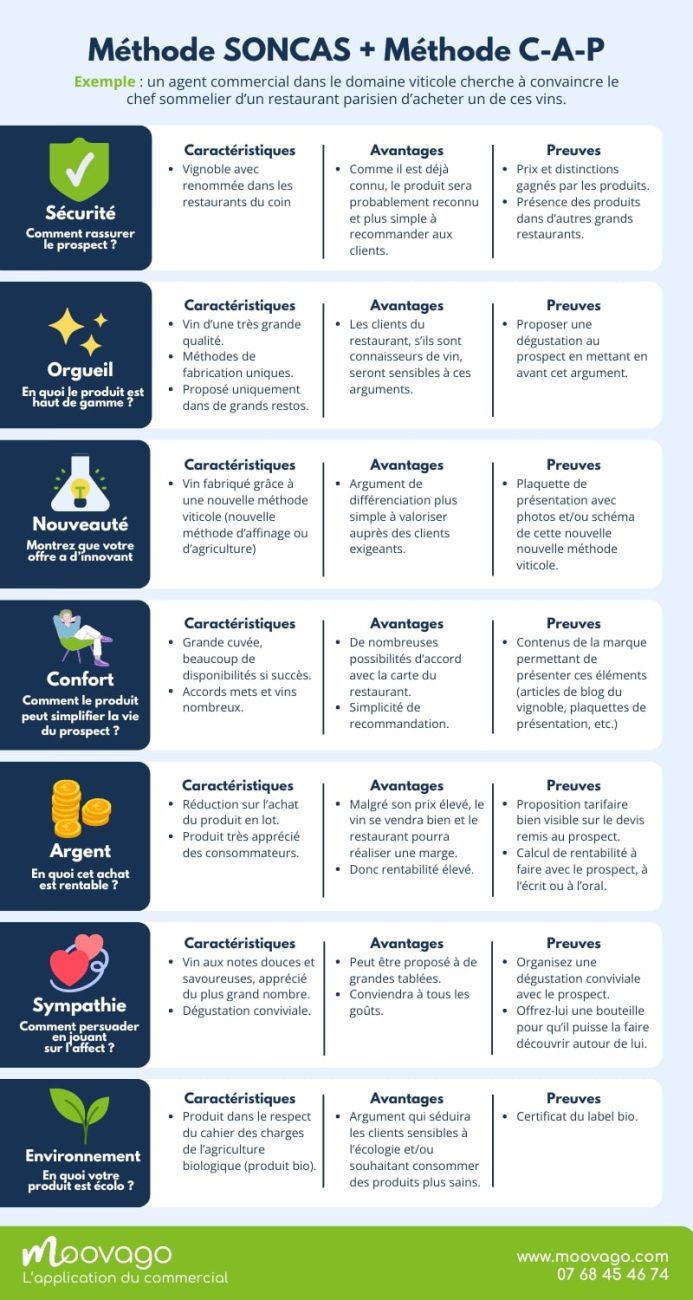The SONCAS Method Definition
Created in 1993 by Jean-Denis Larradet, the SONCAS is a french method is a sales technique aimed at understanding the buying motivations of prospects based on 6 levers. These motivations are easy to remember because SONCAS is actually an acronym composed from these 6 dimensions:
- Security
- Pride (Orgueil in French)
- Novelty
- Comfort
- Money (Argent in French)
- Sympathy
Note that in recent years, SONCAS has evolved into SONCASE to integrate a 7th buying motive, known as Environment or Ecology. We then talk about the SONCASE method (Security, Pride, Novelty, Comfort, Money, Sympathy, Environment).
This sales analysis technique is based on understanding fundamental human needs as it is inspired by Maslow’s hierarchy of needs. Understanding and applying the SONCAS method is essential for sales professionals concerned with adapting to their customers’ needs.
The advantage of the SONCAS method? It is relevant for all salespeople and all sectors. Thus, it can be used with potential customers in B2B as well as B2C to identify the psychological profiles of prospects and clients.
The 6 Levers of the SONCAS Method
The SONCAS method is based on analyzing the deep motivations of prospects or customers, divided into 6 psychological levers (or 7, if we talk about SONCASE). Before seeing how to use SONCAS for selling, let’s see what each of these dimensions corresponds to.
SONCAS: S for "Securité" (sécutité)
The first dimension of the SONCAS method is Security. It’s one of the most important purchasing motives in the sales process.
It’s not for nothing that the need for security is one of the most fundamental needs according to Maslow’s pyramid!
It’s therefore one of the needs that consumers will seek to fulfill first, before considering other purchasing factors. For example, if a consumer doesn’t feel safe at home, they will probably want to buy a video surveillance or alarm system as a priority before thinking about beautifying their home.
More broadly, customers seek to minimize risks when making a purchase decision. If a customer has the slightest doubt, it can compromise the entire sale… And for some customers, this feeling is greatly exacerbated!
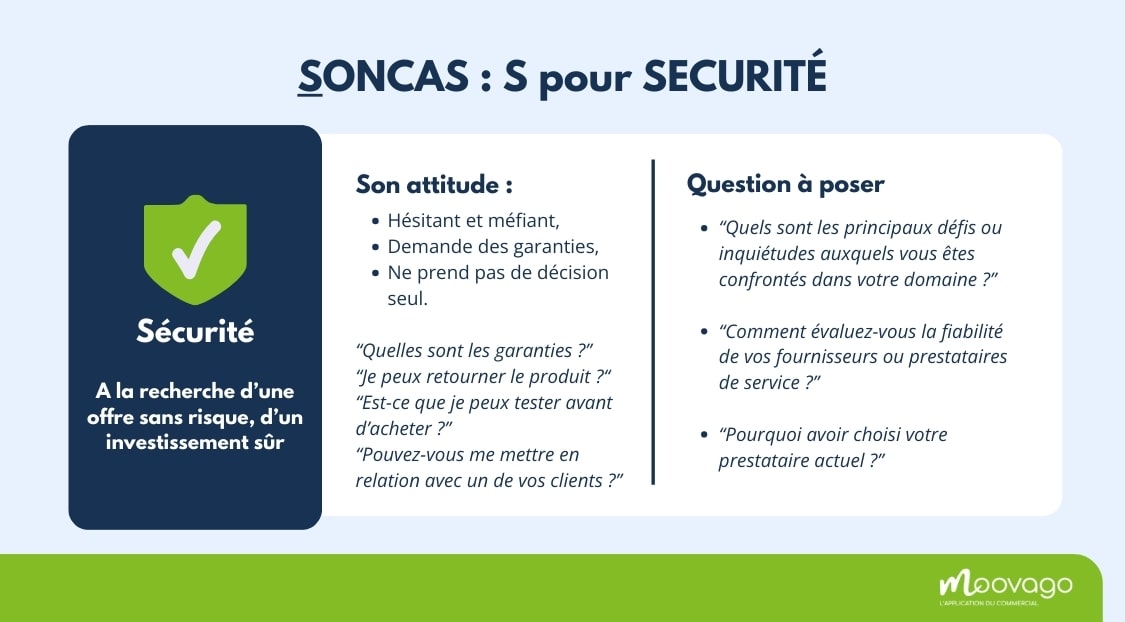
SONCAS: O for "Orgeuil" (Pride)
The pride lever is powerful in sales, as it touches on the customer’s perception of themselves. Customers are often attracted to products or offers that flatter their ego. There is a whole range of products that, apart from their function, have a real social impact and flatter this dimension (vehicles, watches, fashion or luxury watches…).
However, even for more « common » products, salespeople can exploit this lever by highlighting elements that bring out the status, prestige, or unique character of the product.
Customers motivated by pride may be sensitive to:
- Quality
- Limited editions
- Brand reputation and image
- Customization elements

SONCAS: N for "Nouveauté" (Novelty)
Novelty is a powerful lever for many customers. Human beings have a natural fascination with what is new and innovative. To exploit this lever, salespeople must present their product or service as innovative.
Our advice? Highlight how your product is innovative based on your sales pitch and product features. Of course, consumers will expect more from a hybrid vehicle than from a sponge in terms of innovation. However, all products and services can be innovative on their own scale.
So how do you find out how your product or service fulfills this « Novelty » dimension? Here are some ideas to guide your thinking:
- An innovative feature of your product or service (manufacturing, design approach…)
- Your company’s CSR approach
- The integration of trendy elements like artificial intelligence into your product/service
- A new collection
- A new product
- Etc.
Here are some questions to understand if your customer is sensitive to the Novelty dimension:
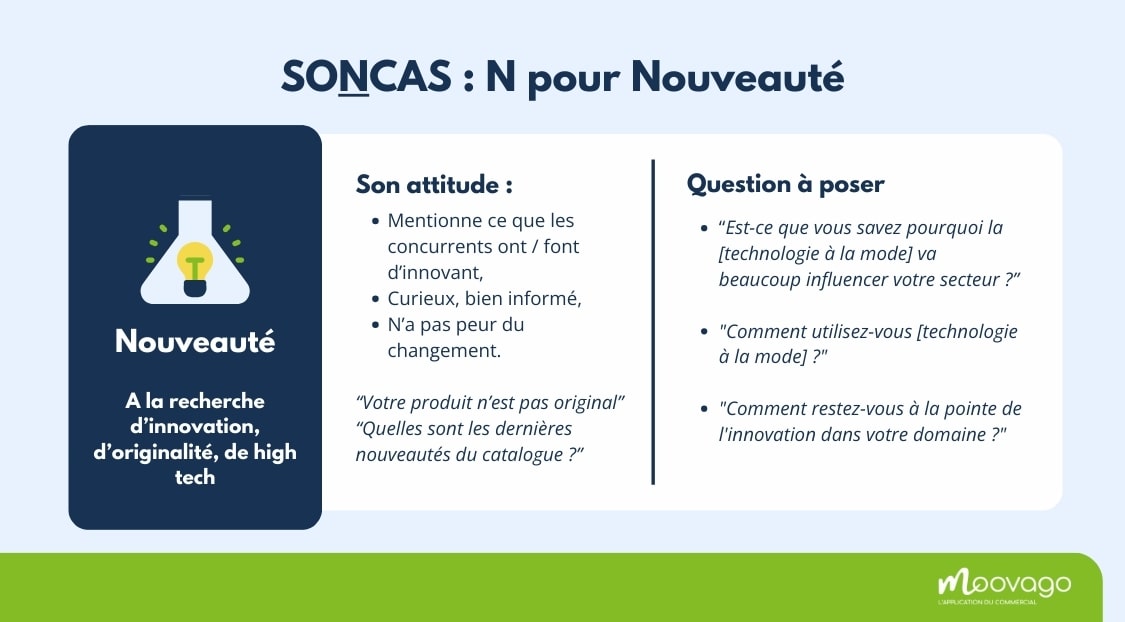
SONCAS: C for "Confort" (Comfort)
Comfort is another important buying motivation. Customers look for products and services that simplify their lives and provide them with a sense of convenience. This also applies to the sales process: a long and tedious customer journey is a considerable barrier for all consumers! It’s particularly for this reason that brands strive to provide the best possible purchasing experience to their prospects. To persuade customers with this type of concern, salespeople should highlight:
- The simplicity of using the product
- How it facilitates daily life
- All the elements at their disposal to facilitate their decision-making, product handling, etc.
- The advantages of the product or service that reduces the efforts necessary to obtain a positive result
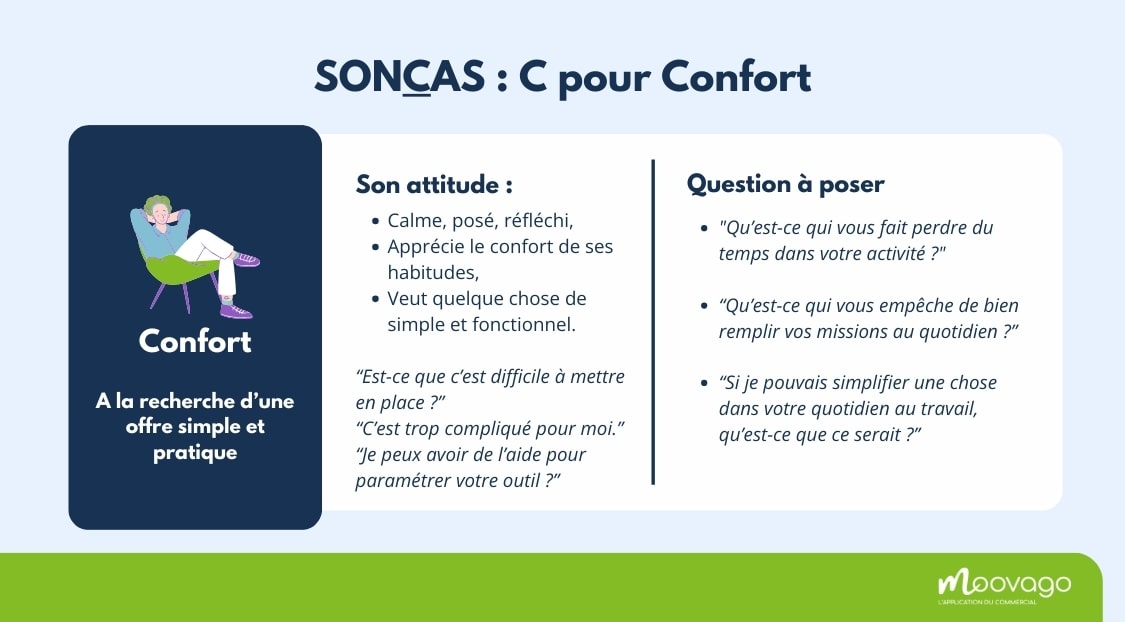
SONCAS: A for "Argent" (Money)
Dear salespeople, we won’t teach you anything by emphasizing that money is a capital lever in sales. Most customers want to ensure that their money is well invested… And that’s quite normal! Salespeople must therefore demonstrate the profitability and value of their product or service.
The higher the cost of the product or service, the more likely the money issue is to become problematic. To make a purchase, your prospect will need to be convinced that they are making an investment in the medium/long term.
Faced with a prospect motivated by money, here are some argument ideas to use:
- Highlight the good value for money of your solution (this applies whether the product is inexpensive or not)
- Emphasize immediate or long-term financial benefits (future savings? a good return on investment? an exceptional product lifetime?)
- Make promotional offers available (even if it means making a symbolic discount)
- Compare your solution to others, less advantageous ones, to support your point
Here’s a small summary sheet for this lever:
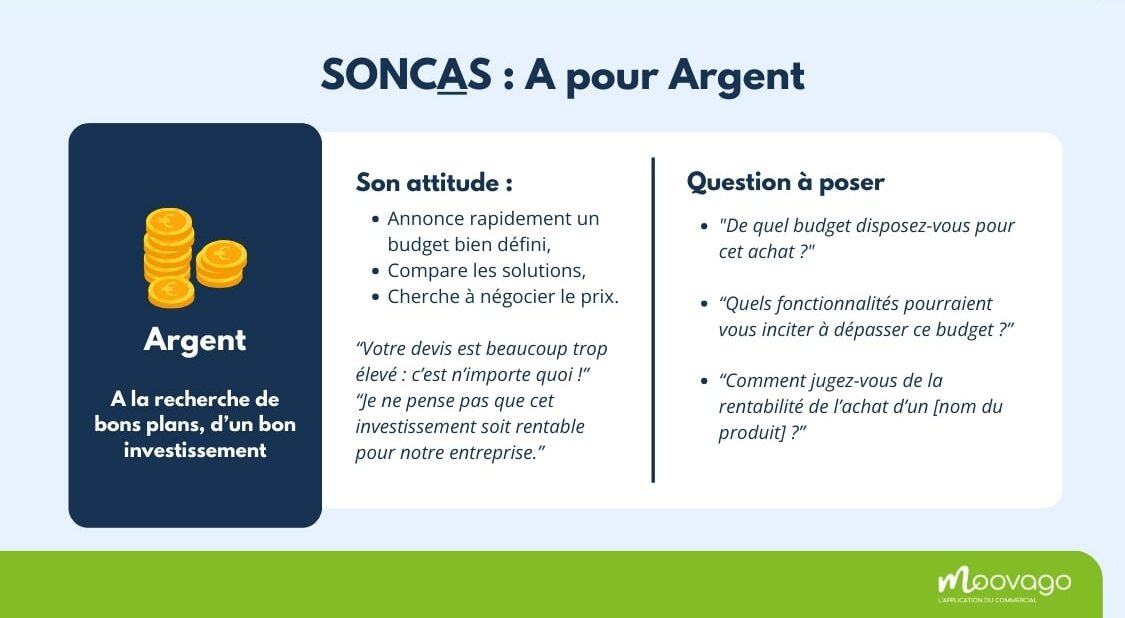
SONCAS: S for Sympathie (Sympathy)
The Sympathy component of SONCAS takes into account two elements that should be clearly distinguished.
On one hand, your prospect’s Sympathy towards you, which can motivate their purchase: your potential customers will be more inclined to buy from you if you have previously established an authentic connection with them.
Here are some tips to put this into action:
- Adopt a listening posture
- Show empathy: put yourself in your prospect’s shoes
- Establish a relationship of trust by showing that you are there to help, not just to sell
- Be honest, transparent, and offer solutions that really meet their needs
- Seek to strengthen your connection with your prospect
On the other hand, Sympathy can correspond to the desire to have a beautiful, pleasant, sympathetic, or friendly product.
For the SONCAS « Sympathy » lever, the SONCAS questions would be, for example:

SONCAS(E): E for "Environnement" (Environment)
The E, of the SONCASE method, refers to a 7th dimension, « Environment ».
This sometimes creates debate, considering that Environment is a novelty, a trend, and can also be associated with « Novelty ».
So, how to take advantage of it?
- Show that your company is eco-responsible. Think about manufacturing methods, products used, etc.
- Emphasize the local aspect if possible: for example, if your products are made in France, say so
- Show that you reduce waste, your carbon footprint over time. It’s also possible to demonstrate that you ensure healthy product composition
- Check if your company meets environmental standards, such as ISO standards. If so, don’t be shy, show it! This strengthens your customers’ trust
For the « Environment » lever, here’s an example SONCAS chart:

Link Need and Solution with the CAP SONCAS Method
CAP SONCAS Method Definition: What is the CAP SONCAS Method?
The CAP SONCAS method is a blend between SONCAS and another sales technique, CAP: Characteristics-Advantages-Proofs.
To use the CAP method, salespeople must follow a 3-step process:
- Identify the characteristics: Start by presenting the distinctive features of your product or service. These elements can include its more or less detailed presentation depending on the prospect; technical specifications, functionalities, important aspects.
- Highlight the advantages: For each feature, identify the benefits it offers to the customer. How does it solve a problem or meet a specific customer need?
- Provide proofs: Provide tangible evidence of the quality and value of your product or service. This can include customer testimonials, case studies, performance data, or certifications.
The CAP SONCAS method consists of combining CAP and SONCAS analyses to obtain the characteristics, advantages, and proofs of your product for each SONCAS dimension (security, pride, comfort, novelty, money, sympathy). It’s up to you to detect the most important buying motives and barriers for your prospect, then to insist only on those that will have the most effect on them (we’ll come back to this later in this article).
The fusion of these 2 techniques allows not only to identify the customer’s needs but also to adapt your sales pitch to these needs. This is generally the reflection undertaken when developing a sales pitch, but it is quite possible to do the opposite: deconstruct your sales pitch to understand which argument to use according to your customer’s buying motivations.
SONCAS Chart: An Example of the CAP SONCAS Method
You’re probably wondering how to use the CAP SONCASE analysis grid for selling with a concrete example?
Let’s see how these two methods can be linked through an example. Imagine a commercial agent for a vineyard, visiting a prospect who is a sommelier in a large Parisian restaurant:
When Should You Apply the SONCAS Method?
Now that we’ve seen what the SONCAS method is and how to combine it with the CAP method, it’s time to get concrete: when does it come into play in your commercial sale?
Often, you’ll be forced to wait for a sales meeting with your customer to have the necessary time to ask your customer/prospect for the information needed to do this analysis, especially during the discovery phase. Once this analysis and preparation phase is completed, the CAS SONCAS method will help you a lot in the following steps (value proposition, negotiation, and closing).
Let’s see this together.👇
How to Use the SONCAS Method During the Discovery Phase?
During the discovery phase, it’s essential to understand the prospect’s needs and motivations.
During a meeting or exchange in the context of a sale, the best tactic is:
- Ask questions, favoring open-ended questions
- Adopt an active listening attitude to get the prospect to talk as much as possible
- Take notes, listen to what they tell you, follow up with increasingly precise open-ended questions to delve deeper into each point
Make sure you ask the right questions! For example, when you think you’ve understood what motivates your prospect, seek to confirm your hypothesis. For this, don’t hesitate to use the questions mentioned earlier in this article and to reformulate to ask for confirmation.
Ultimately, your prospect will naturally express elements related to their buying motivations.
How to Use the SONCAS Method During the Value Proposition Phase?
After identifying what might motivate or hinder your prospect’s purchase, it’s time to deploy the power of the SONCAS method (or SONCASE method) during the value proposition phase.
You have all the cards in hand to present to your potential customer the aspects of your product or service that will make the most sense to them.
👉 Customize the sales pitch that you know so well, and select only the arguments that will have the most impact.
Thus, it’s highly likely that you won’t list all the product features or all the points of your pitch. The idea is to select only what will convince the person in front of you.
How to Use the SONCAS Method During the Negotiation and Closing Phase?
Often, prospects interrupt the salesperson during their presentation on a specific point to argue. This can happen during their presentation (presentation/value proposition phase) or during the negotiation phase, rather towards the end of the exchange.
Don’t panic though: the SONCASE method already provides you with the keys to resolving this negotiation and argumentation phase. It’s very likely that your prospect will highlight elements related to their buying motivations identified with the SONCAS analysis grid.
Not surprisingly, a huge part of the objections that salespeople have to handle are related to money. However, your prospect might dwell on another aspect of your solution if their main concern is not money.
It’s once again up to the salesperson to use their talents to link the Characteristics, Advantages, and Proofs that will dismantle these objections.
How to Use the SONCAS Method in Writing?
Since your exchanges with prospects and customers are not limited to your meetings, it’s obvious that the SONCAS method or even CAP SONCAS can be applied to many other situations.
In writing, for example, during your exchanges by email or message, you can apply the different points mentioned in this article.
Even if writing may seem less natural to you for this exercise, you’ll have more time to prepare your responses and be convincing! Moreover, after your meetings, don’t hesitate to remind your prospect by email of the key arguments of your demonstration, or to complement your pitch with some elements that may have escaped you.
Maximizing Sales Force Effectiveness
To fully exploit the SONCAS method, it’s essential to train your salespeople in this exercise.
Indeed, you must not only know your sales pitch inside out but also master your active listening: that is, to listen while analyzing the buying motive of the person in front of you, and at the same time think about the most relevant characteristics, advantages, and proofs (CAP) to play on this SONCAS lever! In short, it’s a whole exercise that takes time to prepare to be effective!
To ensure that your sales force is ready to use the CAP SONCAS method, make sure that each salesperson:
- Understands the different psychological levers well and knows how to identify them in a discussion
- Has a CAP SONCAS sheet filled in according to the product/service being marketed (and knows it well 😉) which will greatly relieve their analysis work in meetings
- Is comfortable enough with their sales pitch to personalize it according to the identified SONCAS levers.
How to check that the whole team has this knowledge and skills? There are many methods! Training, group workshops, role-playing, feedback… It’s up to you to choose the method adapted to your team to control everyone’s level of knowledge, and give those who need it tools to go further.

